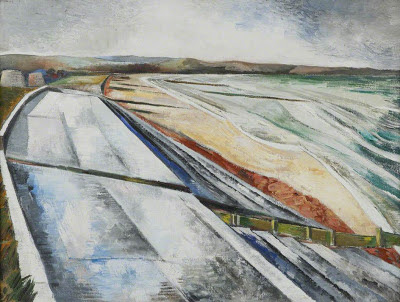Michael Peverett on Lee Harwood
Excellent essay on Lee Harwood at Intercapillary Space. Here’s the opening section:
Six notes about Lee Harwood (while reading
Penguin Modern Poets 19)by Michael Peverett
1. The English Channel
Paul Nash, painting of Dymchurch sea-wall [Image source: from Cathy Lomax’s pretty wonderful blog:
http://cathylomax.blogspot.co.uk/2013/08/paul-nash-and-dymchurch.html]Lee’s poems had about them a remarkable tone. They were ‘quiet’ compared to the work of the Americans I was reading, but they were also surreal. It was a surrealism of everyday things. I often felt that surrealism arrived in Britain as flotsam; objects that floated across the Channel and sat displaced on a beach in southern England. It’s something you can see in the paintings of Paul Nash.
(From Laurie Duggan’s in memoriam post about Lee Harwood:
http://graveneymarsh.blogspot.co.uk/2015/07/remembering-lee-harwood.html)
I wonder if Tim Allen (who grew up on the Isle of Portland) would recognize that particular psychogeographical configuration?
Thinking back to my Hastings days, maybe even (in early childhood) my Eastbourne days, I’d say that I always had a vague sense of it.
A sense confirmed when, much later, I discovered Montale’s poem “Eastbourne” (not that Montale was a Surrealist, but…) , and by the Channel-Islander Jeremy Reed’s translations of Montale in The Coastguard’s House, generously and rightly praised by Michael Hoffman in the LRB; still surely one of Reed’s most stunning achievements.
Maybe it’s something about any town that sharply abuts the sea. The sudden, enormous sea-blankness always intrudes a kind of questioning commentary, a kind of provisionality, into the life of the land.
But maybe, too, it’s particularly something unique about the English Channel. Already when I was quite young, the experience here was not just of enormous sea-blankness but of a pressing awareness that, not very far beyond the blankness, though invisible to us, lay a populous, clamorous and totally different world; different languages, different history, different art, different thinking.
Plus it was a fact that continental visitors, like Montale, were a lot more likely to show up in South Coast towns than in, say, Derbyshire.
It always seemed to me quite natural that my own grandmother, an Eastbourne resident long estranged from her husband, should have nourished her imaginative and emotional life with visits to Paris and Austria. She even made me call her by a German name (Mutti). I never really thought of her as English.
Though I couldn’t see across the English Channel myself, it was obvious that Mutti could.
[I’ve been here before.
In an essay I wrote in 2010 about Elizabeth Bletsoe’s collection Landscape from a Dream (named after a Paul Nash painting), I felt concerned that taking an interest in Nash’s South Coast localities might mean “an unsurrealization of Surrealism”. I’m still not sure if it’s true or not.]
[….]


 Poasis II: Selected Poems 2000-2024
Poasis II: Selected Poems 2000-2024 “Todesguge/Deathfugue”
“Todesguge/Deathfugue” “Interglacial Narrows (Poems 1915-2021)”
“Interglacial Narrows (Poems 1915-2021)” “Always the Many, Never the One: Conversations In-between, with Florent Toniello”
“Always the Many, Never the One: Conversations In-between, with Florent Toniello” “Conversations in the Pyrenees”
“Conversations in the Pyrenees” “A Voice Full of Cities: The Collected Essays of Robert Kelly.” Edited by Pierre Joris & Peter Cockelbergh
“A Voice Full of Cities: The Collected Essays of Robert Kelly.” Edited by Pierre Joris & Peter Cockelbergh “An American Suite” (Poems) —Inpatient Press
“An American Suite” (Poems) —Inpatient Press “Arabia (not so) Deserta” : Essays on Maghrebi & Mashreqi Writing & Culture
“Arabia (not so) Deserta” : Essays on Maghrebi & Mashreqi Writing & Culture “Barzakh” (Poems 2000-2012)
“Barzakh” (Poems 2000-2012) “Fox-trails, -tales & -trots”
“Fox-trails, -tales & -trots” “The Agony of I.B.” — A play. Editions PHI & TNL 2016
“The Agony of I.B.” — A play. Editions PHI & TNL 2016 “The Book of U / Le livre des cormorans”
“The Book of U / Le livre des cormorans” “Memory Rose Into Threshold Speech: The Collected Earlier Poetry of Paul Celan”
“Memory Rose Into Threshold Speech: The Collected Earlier Poetry of Paul Celan” “Paul Celan, Microliths They Are, Little Stones”
“Paul Celan, Microliths They Are, Little Stones” “Paul Celan: Breathturn into Timestead-The Collected Later Poetry.” Translated & with commentary by Pierre Joris. Farrar, Straus & Giroux
“Paul Celan: Breathturn into Timestead-The Collected Later Poetry.” Translated & with commentary by Pierre Joris. Farrar, Straus & Giroux